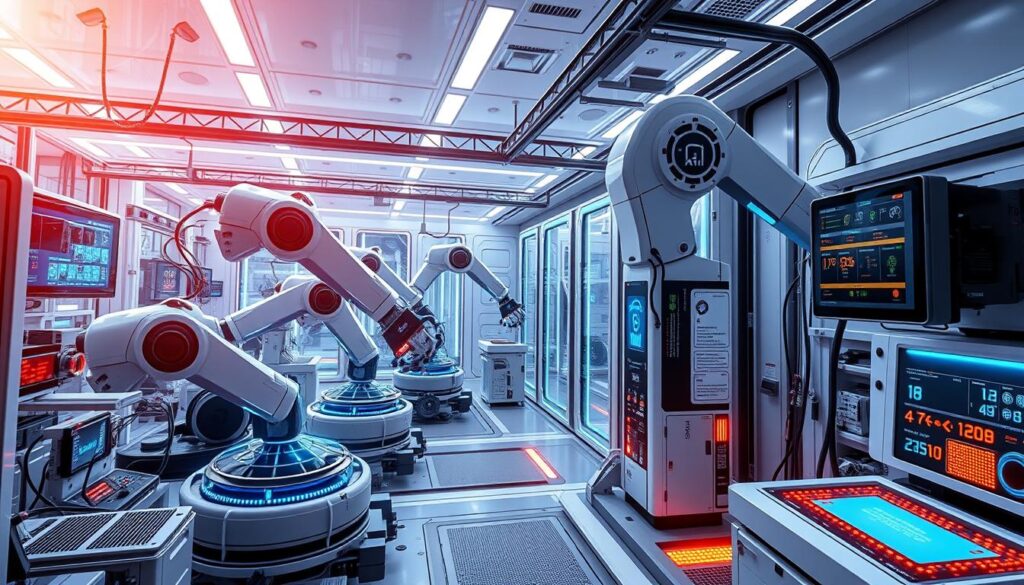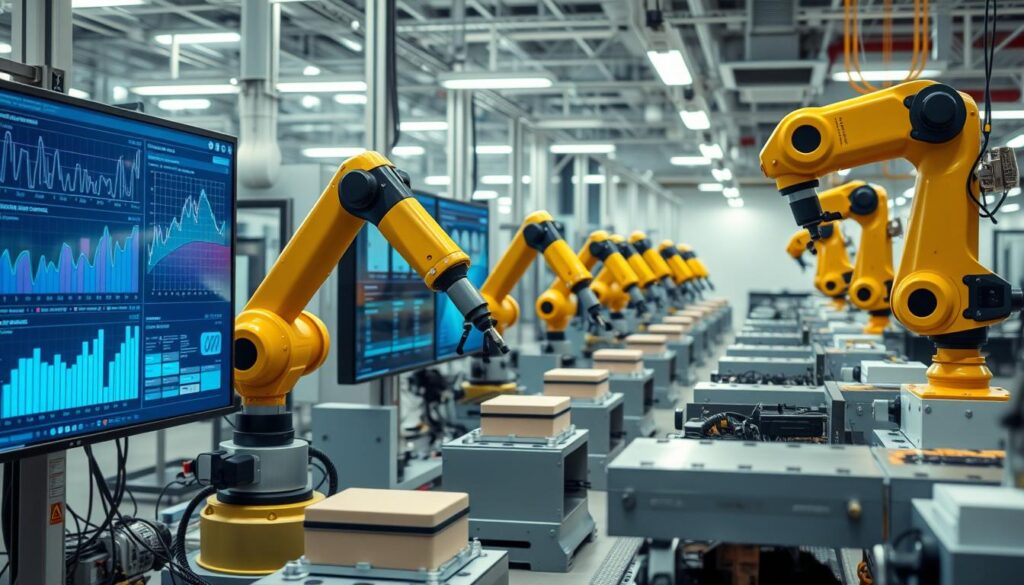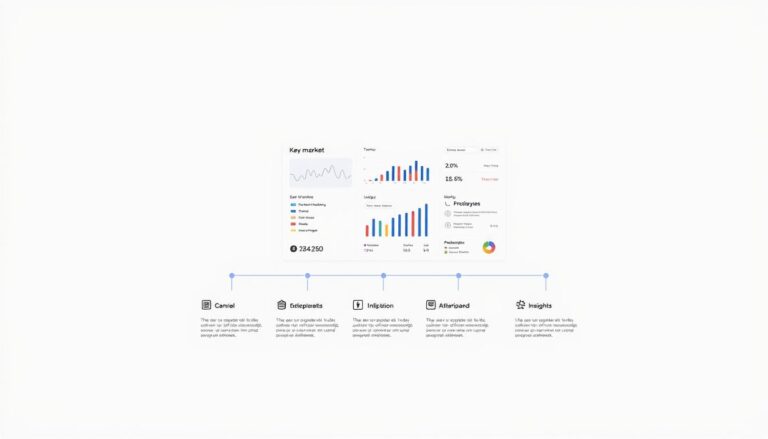In an increasingly complex business world, companies use automation solutions to tackle challenges. These challenges include inflation, supply chain issues, and market shifts. Leaders are realizing that automation is key to improving operations and boosting productivity. It strengthens various areas of a business, like sales, marketing, IT, and finance.
Juan Perez from Salesforce highlights the power of automated solutions. They can analyze data instantly and use artificial intelligence. This boosts productivity and creates personalized experiences. Surveys show over 90% of workers feel automation boosts productivity and teamwork. Thus, employees are happier and more balanced, and companies get more efficient.
Automation isn’t a luxury but a must-have for success today. Take Vonage, which streamlined tasks like account setup from days to minutes. This reduces mistakes. Automation is vital for keeping and growing businesses. It saves money, makes employees happier, and keeps companies competitive.
Key Takeaways
- Automation greatly improves productivity and teamwork, surveys of workers show.
- Lower error rates and quicker decisions are key perks of using automation.
- It’s crucial for better customer relations and employee development.
- Putting money into automation means big savings and better employee loyalty.
- Automation technology will continue to ramp up productivity each year.
- It plays a big role in getting products to market faster and enhancing development.
- The growing automation market points to a high demand and potential for more efficient automated solutions.
Understanding Efficiency Through Automation
Automation plays a key role in making businesses run better. We see how technology changes the way work is done. It makes things more efficient.
Definition of Automation
Automation means using technology to do jobs that people usually do, especially repetitive ones. With automation, people can do more important jobs. This improves how a business performs.
Key Benefits of Automation
Automating tasks helps businesses a lot. About 57% of employers say automation makes workers more productive. Making things more efficient with automation has increased production by 30% in factories. It’s thanks to robots. Also, 45% of repetitive tasks are automated now. This lets workers do more interesting jobs.
Common Misconceptions
Some people think automation only takes away jobs. But real examples show it can save resources and create new opportunities for workers. It helps them learn new skills and get new jobs.
| Aspect | Improvement Through Automation |
|---|---|
| Production Efficiency | Up to 30% increase |
| Error Reduction | Decrease errors by 90% |
| Customer Service | Quicker response times, fewer errors |
| Order Efficiency | Increased by 10X |
| Pricing Optimization | Automated tools recover over $50 million in annual gross margins |
Overall, we should see automation as more than just a way to lower costs. It’s key for being more efficient and growing. Using automation helps businesses stay ahead in a tough market.
Types of Automation Solutions
Businesses are using tech to make their operations smoother and more productive. They look at automation solutions like robotic process automation, AI-powered automation, and workflow automation. These tools change how work gets done today.
Robotic Process Automation (RPA)
Robotic process automation mimics human steps in digital systems to get work done. It’s best for tasks that are the same and done often. RPA makes things move faster and reduces costs, providing quick benefits to companies.
AI and Machine Learning Applications
AI automation does more than just repeat tasks – it can think and learn. With AI, companies can deal with complex information and adjust as things change. This improves how companies operate and how they serve their customers.
Workflow Automation Tools
Workflow automation tools help data move smoothly between tasks and systems. They reduce the need for typing things over and over and cut down on mistakes. These tools are key for keeping teams on the same page and making sure work flows well.

| Type of Automation | Best Suited For | Specific Industries |
|---|---|---|
| Fixed Automation | High-volume production | Electronics, Automotive |
| Programmable Automation | Batch production | Manufacturing, Textiles |
| Flexible Automation | Variable product types | Consumer Goods, Pharmaceuticals |
| Integrated Automation | Full plant automation | Chemical, Oil & Gas |
This table shows how different areas use automation to work better, meet market needs, and lower costs. With robotic process automation or AI-powered automation, companies aim to innovate and grow in an automated, efficient setup.
The Role of Automation in Various Industries
Automation changes many industries by making work faster and better. By looking at certain areas, we see industry-specific automation changing their whole scene.
Healthcare Automation
In healthcare, healthcare automation has changed how we care for people and manage tasks. It helps in surgeries, giving out medicines, and watching over patients. This new tech helps patients and makes work lighter for doctors and nurses. Automated systems in hospitals keep patient records with fewer mistakes. This makes sure the information is safe and correct.
Manufacturing Efficiency Improvements
Automation has greatly improved how we make things. Using robots and systems like CNC technology lowers costs and makes products the same quality. Robots do tasks with care, making things better and faster than people can. Using automation on assembly lines cuts down on stop times and wasted materials, raising overall work output.
Financial Services Automation
The finance world gains a lot from financial services automation. It makes transactions and managing risks smoother. Automated systems make decisions faster and keep money tasks accurate. This includes trading, finding fraud, and sticking to rules. This tech helps banks and others give steady services, making for happier customers and reliable operations without overworking people.
| Industry | Automation Impact | Key Benefits |
|---|---|---|
| Healthcare | Improved patient care and reduced clerical errors | Efficiency in patient data management, enhanced diagnostic accuracy |
| Manufacturing | Higher production rates, improved product quality | Reduction in material waste, minimized production costs |
| Financial Services | Faster transaction processing, improved compliance | 24/7 operations, reduced dependency on human clerical work |
This info shows how automation is key in today’s industries. It makes work more efficient and safe. Automation helps these areas handle more work with speed and care.
Implementing Automation in Your Organization
Starting to automate your business involves understanding your operations well. It means identifying what needs to be improved first. This ensures that automation works well, making things more efficient and supporting growth.
Assessing Current Processes
Looking at your current workflows is the first important step. It’s about finding tasks that take up too much time. A Deloitte survey shows that 13% of companies use over 50 automated systems, a big jump since 2018. By knowing where to focus, you can make automation work better for your business.
Developing an Automation Strategy
Creating a smart automation plan is key. Tools for efficiency like RPA, AI, and workflow platforms need to fit your long-term goals. BPA is good for big changes, while RPA suits smaller tasks.
Choosing the Right Automation Tools
It’s vital to pick tools that grow with your business. These tools should make things faster and offer a good user experience. Using low-code platforms allows quick changes, even for non-tech people. This lets everyone help improve efficiency.

But remember, automation isn’t just about starting. It’s about keeping things better over time. Regularly update and tweak based on how things are going. This keeps automation effective.
| Key Focus Area | Benefits |
|---|---|
| Employee Productivity | Reduces time spent on repetitive tasks, allowing focus on higher-value activities. |
| Operational Efficiency | Minimizes errors, reduces operational costs, and shortens turnaround times. |
| Customer Satisfaction | Enhances service quality through quicker and more accurate task execution. |
| Scalability | Supports business growth without a proportional increase in resources. |
To wrap up, automating the right way means tailoring your approach. By evaluating what you do, setting a clear plan, and choosing the best tools, your business can grow and get better.
Measuring the Impact of Automation
In today’s world, companies use automation to stay efficient and relevant. It’s important to measure how these technologies affect productivity and happiness at work.
Key Performance Indicators (KPIs)
Businesses must set clear KPIs to measure automation’s success. They look at cycle times, errors, output, and savings. This helps see if automation is really working.
By comparing performance before and after automation, companies can see its true value. They also learn where they can do better.
Analyzing Data for Continuous Improvement
Reviewing data from automation helps companies improve constantly. They examine process speed increases and innovations from AI. This helps them know what’s working well and what needs work.
This approach keeps productivity growing. It also helps companies stay up-to-date with tech changes and market needs.
Employee Feedback and Engagement
Knowing how automation affects employees is key. Surveys and feedback show how staff feel about automation tools. This tells us about their job happiness, stress, and morale.
Automation aims to help companies reach their goals. Watching KPIs, analyzing data, and listening to staff ensure automation works for everyone.
Challenges of Automation Adoption
Automation brings major benefits to various fields. But, the challenges of automation show up during the start. They can heavily influence the process and success of automation in businesses.
Resistance to Change
A big hurdle in automation adoption is employee resistance. They often stick to the old ways. Around 80% of industries see pushback at the beginning. Beating this issue requires solid change management plans. This includes full training and explaining the benefits of automation for every job.
Integration with Legacy Systems
Merging automated systems with old ones is tough. About 65% of businesses struggle with this due to compatibility problems and complex old systems. To integrate them well, big IT updates or even a full system change is sometimes needed. This ensures smooth operation and keeps data flowing right.
Cost vs. Benefit Analysis
Doing a deep cost-benefit analysis is key to understand automation’s value. Automation can improve work and efficiency, but starting costs of tech and training are high. Setting clear goals and knowing the financial and operational effects are crucial. This helps justify the expense and align with business goals.
Dealing with these challenges of automation well can make implementation more successful. It needs careful planning, readiness to make changes, and a commitment to always get better and adopt new tech.
Best Practices for Successful Automation
Successful automation is all about having a good strategy. It’s about applying the right practices to improve how things work. When done right, it can make a big difference in productivity and efficiency for any group.
Start Small and Scale Up
Automation doesn’t happen all at once. Starting small lets groups show off quick wins and real benefits. It’s a way to show that automation works. It also helps build up to bigger projects.
As things move forward, it’s possible to tweak and get better. Learning from each step is key. This way, the path to doing more with automation becomes clear.
Involve Stakeholders in the Process
Talking and working with stakeholders is key to automation success. Keeping everyone on the same page helps get their support. When leaders and the team are excited, it drives the project forward.
Having stakeholders help test things can ease worries and increase trust. It makes the project stronger and more likely to succeed.
Monitor and Adjust Regularly
Just setting up automation isn’t enough. Keeping an eye on it and making changes is needed. This lets groups tackle new challenges and keep improving.
Staying proactive is vital for keeping up in today’s world. It encourages everyone to always look for ways to do better.
Technical Considerations and Workforce Engagement
- Automation with robotics brings better accuracy and speed to manual tasks.
- Choosing a partner company for automation adds expertise and helps smooth things out.
- It’s important to get the team ready to handle new automated systems or watch over them.
Following these top practices for automation helps make it a powerful tool for growth. With thoughtful planning, including everyone, and making changes when needed, getting digital transformation right is more likely.
Future Trends in Automation
The automation landscape is changing fast. It’s shaping the way companies function and compete. As digital advancements grow, we look to the future. Automation’s next trends offer efficiency, innovation, and big changes. This includes the rise of easy-to-use platforms and new ways for workers and businesses globally.
The Rise of No-Code and Low-Code Platforms
No-code and low-code platforms have transformed automation. They make technology easier for everyone to use. These platforms let people without technical skills create automated systems. This encourages innovation and speeds up business reactions to market changes.
They’re becoming more popular and look set to change automation’s future. Anyone can now set up automated workflows easily. This boosts productivity and business resilience.
Automation and the Gig Economy
Automation is changing the gig economy too. It’s making it easier to connect freelancers with jobs. This helps businesses use talent better and makes work more dynamic. Plus, companies like Walmart are using automation to improve operations.
By 2026, 65% of Walmart stores will use automated systems. This shows automation’s big role in making businesses more scalable and efficient.
Predictions for Workforce Transformation
Automation will also change job dynamics. The World Economic Forum says AI and technology could create 97 million new jobs by 2025. Jobs will evolve, pairing human creativity with machines’ efficiency. This shift will focus more on strategy and innovation.
Yet, this change brings challenges, especially in AI ethics. Thoughtful AI use is necessary. Still, the blend of human skills and automation will lead to major workforce changes, fostering innovation and continuous learning.



